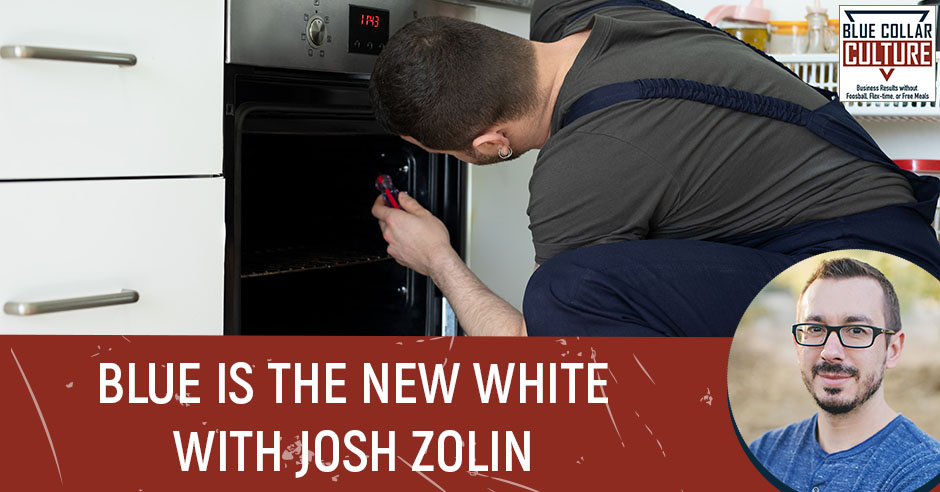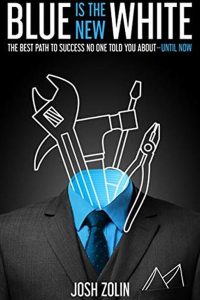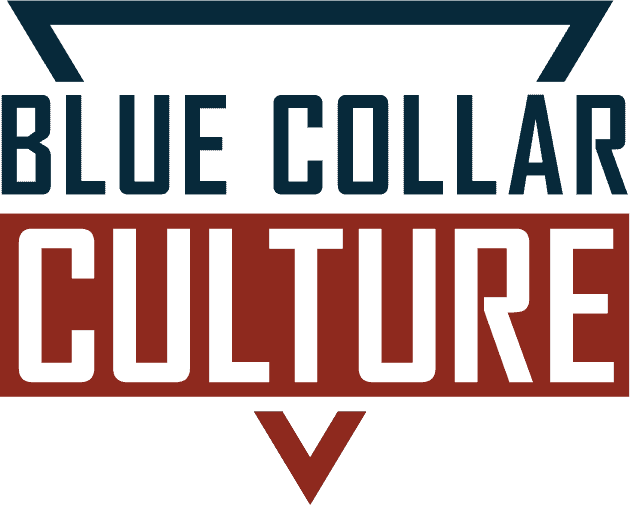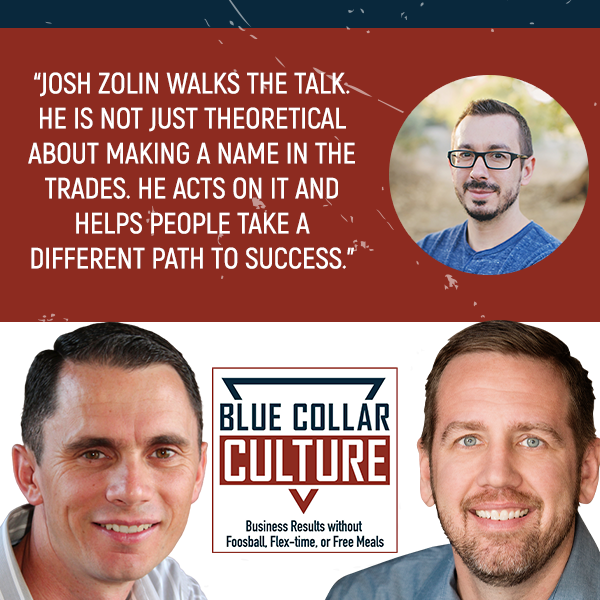
It’s no secret that there is a labor shortage in the trades and it’s no secret that a lot of the younger generation has turned away from it. There are so many things stacked against employers right now that make it a lot harder for them to make the next generation excited about getting into the trades. The CEO of Windy City Equipment, Josh Zolin, thinks this is mainly a result of the societal norms pushing the perception that blue-collar jobs indicate a lack of success. In his book, Blue Is the New White, Josh emphasizes how some of the most lucrative jobs out there are blue-collar jobs. Josh joins Ryan Englin in this episode to discuss how there is more than one path to a stable career and a great financial future. Success doesn’t always have to mean a college degree and Josh is here to clear that trade misconception.
—
Blue Is The New White With Josh Zolin
I have known our guest for this episode for a little while, and it wasn’t until someone called me out and said, “How come he hasn’t been on your show yet,” that made me think, “I need to fix that.” Our guest is Josh Zolin. He’s the CEO of Windy City Equipment. They are a leading commercial facilities maintenance company specializing in HVAC/R and kitchen equipment.
He’s grown up in the trades and has been doing this for a long time. He wrote the book on what it takes to get started in the trades. It’s no secret that there is a labor shortage in the trades, and a lot of the younger generation has turned away from the trades and said, “I want to go do something else, be an influencer, a TikTok star or go into software development.” They have turned away from this.
There are so many things stacked against us as employers when it comes to getting the next generation excited about getting into the trades but in Josh’s book, he builds an amazing case for why blue-collar jobs are the way to go in the future. I’m excited about this conversation. Make sure that if you have thought about any way to bring new people into your apprentice program, training program, or maybe struggled or need a new set of ideas, this episode is for you.
—
Josh, I’m excited to have you here on the show. What is one of the biggest myths that you see in the trades?
There are so many to choose from but first, thank you for having me on the show, Ryan. I appreciate it. I have been eyeballing this show for a long time, and it’s an honor to finally be on it. One of my favorite topics is the myths of the trades. The one that stands out over anything else is that the skilled trades are second-rate careers. It’s what you do if you can’t cut it in college or you are not smart enough to do what all the rich people do. It’s that fallback for a career that people don’t appreciate and give any merit to. If you can’t cut it going to the college route, you can always be an HVAC tech, a contractor, a carpenter or a bricklayer, whatever it may be.
It’s almost like that’s where the dropouts go. Those that were rejected by the system can go into the trades and make a lot of money getting to do something they enjoy. We won’t talk about that yet.
The sad part about it is that I’m sure that some of the older generation reading might be able to relate to this but there used to be a course in high school called the Industrial Arts. It is a shop class where all the “losers and rejects” were all sent because nobody thought that they would be able to succeed anywhere else. The problem is all the people that were sent there adopted this mindset, too. A lot of the people in the skilled trades think that they are in the skilled trades because they couldn’t do anything else. That’s one of the perceptions that we’ve got to shatter.
I’m going to date myself here but as you were talking about that, it made me think of the movie Grease. They were all the dropouts and rejects in a shop class together.
The skilled trades are more than just second-rate careers Click To TweetThat’s exactly what we do in the trades. We sing and dance.
You wrote a book on this. You are a published author. Your book goes to a lot of schools. Wholeheartedly, if we don’t get in front of the next generation of workers and when they are young before they are influenced to be a TikTok star because that’s the thing and say, “There are these great lucrative careers that are never going to go away. You can’t be replaced with robotics and technology. It can’t be done.”
Are those things going to come and help the trades? Absolutely. We are not going to ignore that but you need human beings with their hands, eyeballs, and brains out there doing this stuff. Tell me a little bit about the book. What was your motivation for that? How is this something that our readers can use to help them start thinking bigger about, “How do I grow my future team?”
Technology can’t replace skilled tradespeople. I always have this image in my head of a Roomba trying to climb a ladder. It doesn’t work but in all seriousness, you are right as far as that’s concerned. The book was a passion project of mine. I own a company in the skilled trades. We repair HVAC and kitchen equipment commercially. I have lived it and been in the trades. Prior to being in the trades, I was on the opposite end. I never went to college but I wasn’t working with my hands. Let’s put it that way.
Once I’ve got involved in the trades and was able to see the opportunities that existed, I’ve got to thinking. I’m a lifelong learner. I try to learn in any way, shape or form that I can. While I was in the trades coming up the ranks, I couldn’t find any material, guides, literature, or anything to tell me what to expect, what opportunities existed, or what pitfalls to be aware of. There was nothing like that out there.

Fast forward a few years, I began to grow the company that I was working with and started to understand that the skilled trades were more than just a second-rate career. As I was bringing on new technicians and competing with all of these other companies in my area, I saw what these guys were making and what they were asking for coming in like full benefits and $35 an hour.
This was years ago, so you can only imagine what that looks like now but right at the time, that kept ringing in my head that there was nothing to tell the world that this was the case. Unless you were in the trades or you had family in the trades, there was no way to know that you could make this money, be this successful in the trades or there were these many opportunities and trajectories.
Once I was able to move up in the ranks, even more doing what I do, I thought it was time to inform the people that needed to be informed. What I mean by that is parents, educators, children, children in high school, and high school agents. The book highlights what it means to be in the trades, who should go into the trades, how you move through the trades, and how this industry can affect your success, however you define that success.
It was very difficult to walk this line but it’s written in a way that speaks to young people with the language that young people use while also providing enough facts and references to where educators can see it as a viable resource. Walking that line was a little bit tough but once I released it and I was starting to get all this feedback and everything, it was a great success. I’m blessed that people loved the book, and that’s fantastic.
People are naïve to think that every single person and every single student in the school system will fit in their neat little box and will want to pursue a college education. Click To TweetI’ve got to understand that if we want to make a difference in this industry, it’s got to start well before high school. That’s my main demographic. Some of the languages I use in the book are very questionable. You can’t put it in front of an elementary-aged kid but that’s how deep this perception is ingrained in our society.
By the time kids reach the age where they are going to determine what they are going to do for their career for the rest of their life, they already have an ill perception or no perception of the skilled trades because they haven’t been talked to about it when they were younger. That’s the ultimate reason why I wrote the book and the basis that it covers. Hopefully, in the future, there will be an edited version I can give to.
I have read the book, and it’s a good book. It’s a quick read too, which I liked. It didn’t get hung up on a lot of stuff. There are some great testimonials in there. You bring up some examples of people who didn’t think they could make it in the trades, and they made it. It was great to see that you are not just theoretical about it. You are walking the walk and taking people through it.
It’s a good book for anybody who wants to think about, “Is there another path besides college?” A big piece of the book is you are comparing and contrasting this to the typical way of getting out of high school, going to college, getting a degree, hopefully, getting a decent job, and spending the next decade paying off your student debt. That’s what we tell our kids. I’m with you on that.
One of the things that we talk a lot about over here at Core Matters is that the industry has done itself a disservice. You were talking about how the kids don’t get taught that this is an option for them at a young age. Just so we are clear, it’s not the kids that are choosing this. It’s their parents saying, “No kid of mine is going to be a plumber because a plumber smell, and there are butt crack jokes.” There are all these other things about being a plumber.

“No kid of mine is going to go tell people they are a plumber. I am not going to tell my friends that my kid is a plumber. My kid is going to go do something respectable.” That’s the mindset. This is unfortunate but there is a whole group of companies out there that have been causing people to look at these industries as lesser than because of their marketing, the way they talk about the industry, and frankly, the way they have treated some of the people in the past.
There’s a funny story about that speaking of plumbers. I’ve got a podcast as well, the same name as the book, Blue is the New White. I had interviewed this guy named Bob. He’s a plumber by trade. He owns his plumbing company but when he was in high school, he went to his counselor and said, “I want to be a plumber. My dad is a plumber.”
His counselor looked right at him and said, “You are too smart to be a plumber. Go to college for Computer Programming.” He did. He failed and flunked. He was down and hard on himself. He got back into plumbing and got a multimillion-dollar business. That dude is pulling seven figures a year personally. If he would have listened to his counselor and not gotten back into the trade, God knows what he would be doing. You are right. It’s a sad truth.
Something that you do well in the book is for those parents that are open to the kids reading the book, which you work with a lot of schools on the book, it opens our eyes to say, “There is another reputable path, and it’s something that I can be proud of.” Look at you in HVAC, you’ve got your company and own podcast. Just because you go into the trades doesn’t mean you have to stop at being a technician. There’s that belief, “I will be a plumber for the rest of my life,” but your friend is making seven figures. You are never going to do that working for someone else.
It’s that perception that has been ingrained into us, “A plumber must fix toilets all day long for the rest of his life until he dies.” That’s not the case. When you talk about college education and route, it’s important for people out there to know that I’m not anti-education. I’m pro with the right education for the right individual. We are naive to think that every single person and student in the school system fits in this neat little box. They are well-equipped and suited for college or even more so that that’s what they want to do. Even if they are well-equipped and suited for that environment, some people love to work with their hands.
The right decision may not always be college. Click To TweetWhat I preach about is we know that college is astronomical in price. You had commented on paying off student loans for the next decade, and it’s sad but true. It’s a trillion-dollar debt crisis in the student loan industry. Not many people know but they are not forgivable. If you were to go bankrupt or anything like that, you can’t forgive the student loans. You still owe on that. It’s a very impeccable system for those who write loans but not so much for the individual.
For me, it boils down to the ROI. College can be beneficial if you know for a fact that you want to be a doctor, a lawyer or a CPA. Hats off to you. We need you guys too but for the buildings that you work out of, don’t forget who built them. It’s the bottom line. When you talk about the skilled trades, the available apprenticeships, some of the unions that are out there, and stuff like that, you can get paid to get this education instead of paying an arm and a leg and digging yourself a hole of debt through your formative years.
In the book, I’ve got spreadsheets and diagrams of the typical wage when you come out of college compared to your typical wage if you were to jump into the trades right after high school. It surprises some people that those wages are very similar to one another. Some startling statistics revolve around that as well.
This is the stuff that needs to be talked about, Ryan, and nobody is talking. You and I are talking but this has to circulate through the school system because it’s about the success of the next generation. It’s not about the success of the school, the counselor or the teacher. It’s about the collective success of our entire economy, our country, and each child.
I’m going to shift us a little bit after that because it was a great tee-up why you do this, the book, and the value it can bring. I work with a lot of business owners all over the country. One of the questions they always ask me is, “How do I find people that don’t know the trade exists? I want to build an apprenticeship program. I’ve got a robust training program. I will take someone who has the foundational behaviors and skills that make for someone being good in the trades. I will teach them the trade but I can’t find them. I don’t know where to get them, how to get in front of them at the schools or do these things.”

What advice would you have for those people that say, “I’ve got this apprenticeship program?” A lot of people are saying, “He’s maybe a military vet.” You’ve got out of the military, and this is a great career transitioning, so you have to work with your hands and have that team environment that you had there or these kids coming out of high school that doesn’t want to go to college but feels like their parents are forcing them. Can we get in front of them and let them know these opportunities existed? That’s what you do a lot with the schools. For those business owners that are thinking, “I’m ready to build for the next generation but I don’t know how to get started,” how can they get started with that?
That’s not an easy question to answer by any means. It’s the question I have been trying to answer for the last years ever since the book came out. There are a couple of things that we can do. Number one, from marketing play, we need to appeal a little bit better to that next generation. This is the intangible long-term stuff. A big reason why nobody wants to come into this industry is because of the reputation of the industry. It was different years ago. That’s what the parents remember. We are not in the same position we were back then.
We have to market it and let them know, “It’s hard work but we are using a ton of awesome technology that these young people are using as well. Our industry is starting to use that technology, too.” That could create some more of that appeal. When people think of the skilled trades, they think of tools, irons, and hammers. It’s a hard concept for them to even understand that there could be technology involved.
Above and beyond that in working on your blue-collar culture, which you know something about, to get in front of these students takes a big push. I don’t like talking about what everyone is already doing. Everyone is already recruiting out of trade schools, posting these job ads, and looking for apprentices. It’s about how do you get them before they decide to go to college because the right decision may not be college?
It takes a bigger push in the high schools, getting in touch with the school counselors because they hold the key. If you can convince the counselors that this is a good career path, they will convince the students that this is a good career path. We might be focusing on the wrong thing. We are focusing on the individual, not who influences the individual, which is why I wrote the book.
All of the stuff is around us revolves on skilled trades and it’s just being taken for granted. Click To TweetReach out to your local high schools, bring my book if it helps, have a meeting with the counselors, and say, “This is what your students can do. Coming in, I will give them $18 an hour to start, $19 an hour sometimes, not having any experience whatsoever.” That’s what this industry is demanding. It’s amazing. If you do the calculations for $18 an hour, and chances are you are going to get raises over the next four years, what are you going to be making in four years? Put this in front of the counselors. Show them so they can help do that recruiting for you. That’s a big thing that we miss.
The other thing is also to encourage your team to have and adopt that same mindset. You alluded to it in the show, “I don’t want you doing what I do. We don’t want you being in the trades.” That’s a big thing with some of the older generation that are in the trades. They think that college is the best path because that’s what they were taught so that’s where they are pushing the next generation because they think that it’s better when in reality, it’s a different day and age, and may not be the case anymore.
There are a lot of companies out there, especially if they have been around in the community for a while. They will sponsor a Little League or get involved in some of the youth sports. They do it to give back to the community but there’s always that ROI like, “I’m investing in these kids. Maybe their parents and they will take notice.”
I could see, especially if you are sponsoring a high school football team or something like that as part of your sponsorship agreement, everybody gets a copy of your book. Not to sell more books for you, Josh, but that’s a way to get the books in front of the students. What we need is for them to get this message. That’s why I thought it would make so much sense for you to be on the show with me because there is a lot that we can do to get in front of the kids but it’s going to take a team effort.
You are not going to do it by yourself. None of our readers are going to do it by themselves. It’s a little bit of effort over a long time. This didn’t get broken. I always ask people if they have ever remembered that picture from the ‘30s. It’s a New York skyscraper, and everybody is sitting on the I-beam eating lunch.

I have heard stories of kids growing up going, “I want to do that when I get older.” It used to be cool to be in the trades but it’s not anymore. The trades are cool. Don’t get me wrong. That’s my entire focus but for whatever reason, knowledge work has come out, TikTok and all of these Facebook things. That’s what people want to do. They all want to be an influencer.
It’s pivoting how we talk about what it is that we do. Everybody wants to be a TikTok star, and that’s great. I wonder what the world would look like but if we were to pivot the conversation like, “These phones have to charge. You have to plug these phones into something to get them to work so you and your friends can be on TikTok. Do you know who supplies that electricity? It’s electricians.”
This stuff is all around us, Ryan, and it’s taken for granted. You walk past that sock on the dryer one million times a day, so you don’t give it a second thought. How do you get to work in the morning? You need mechanics. How do you remain comfortable in your office? You need HVAC. How do you get the electricity for your TikTok? It’s all electricians. How come you are not exposed to the elements? It’s glaziers who make the windows.
When you look outside your window, and everything isn’t rubble, it’s because people are out there paving roads and planting trees. It’s everywhere. You can’t throw a rock without hitting something that’s a result of the trades. There are so many different ways to relate it to anything that you do. As an industry, we are failing to do that. We are perpetuating. “Come fix HVAC and toilets.”
What are some things that you have seen work? You have been in the industry for a while and wrote a book on this. What are some things our readers could do if they want to start getting in front of the next generation? Not even go to the schools.
If you really want to make a difference, you have to do things that you haven't done before. Click To TweetYou’ve got to start speaking their language. Everyone doesn’t want to hear it but I’m going to say it. Be on TikTok. I hope that doesn’t sound super hypocritical. I’m not on TikTok yet, but it doesn’t mean I don’t know that I should be. If we want to make a difference, we’ve got to do things that we haven’t done before. If we want to attract a generation that has never been in the trades, we have to do it using ways that we haven’t tried.
Social media is a big one. You are seeing more because there is a lot of tradespeople. The thing about tradespeople is they take a lot of pride in their work. When you are in the trades, working with your hands and fixing this stuff, you want to show and tell people because it’s awesome. You get a great sense of accomplishment.
Where I’m going with that is that there is a lot of tradespeople out there that have Instagram and TikTok accounts, maybe a little more Instagram than TikTok at this point. Also, Facebook groups and they are starting to filter in on LinkedIn a little bit more. We are getting there. We are just not all the way there. If we could, as an industry, we would be able to change some minds. Not all the minds but some.
If I had my guys on TikTok showing how we use cranes to set units on rooftops and stuff like that and we’ve got people directing using hand signals, there are people out there that would be interested. How about the view of the sunrise or the sunset when you are up there on the roof fixing a swamp cooler or whatever it may be? Using that same thing to highlight some of the things that the trades allow you to do that you wouldn’t otherwise have an opportunity to do.
There’s a resort at the bottom of the Grand Canyon called Phantom Ranch. I don’t know if you have ever heard of it but there’s a waitlist to get on it. You have to wait for three years. It was years ago that they called us because they had a problem with a piece of equipment. I had to send a technician. There are only two ways to get down, mule or helicopter. Unfortunately, they weren’t willing to spring for the helicopter but he did get to go down on a mule. He put his tool bag on one mule and him on another.

This is a true story but he went all the way down the mountain and got them fixed. He was able to stay at that resort overnight for free and got paid to stay overnight. He got his hourly wage plus per diem. He stayed in this resort that you couldn’t otherwise get a reservation to no matter how hard you try. If we could highlight some of this stuff, and that’s only one small example. I have heard people flying all over the world for repairs and things like that. It happens all the time. To answer your question, we need to up our marketing game a little bit.
Let people know that this stuff is cool. I get a lot of it, especially if you have been in the trade in a while, you take it for granted and you are like, “It’s the same thing over and over,” but it’s not. For the people that don’t know, the stuff that you do is cool. At your company, you recorded all of this stuff and got your technicians walking people through it. I have seen some of it and I was like, “This is cool stuff.” I’m a little geek when it comes to some of the stuff in the trades.
The idea is we do need to up our game and let people know it’s cool. I love what you said, “Go where the next generation is.” Don’t expect them to come to us anymore. They are on TikTok. There are probably social media I don’t even know exists because I’m not that generation but that’s where the high schoolers are. Go get in front of them there. One of the things we coach is to stop putting so much effort into getting new customers. Start putting your marketing effort into getting new employees. That’s right in line with what you said.
Josh, I enjoyed it. I love how you talk about this. The passion and excitement come through. I know there are people reading who want to get ahold of you either because they want to buy a bunch of books to give to that Little League team or want to consume more of this content and be more around the ideas that you have. Let us know how we can get ahold of you.
I’m @JoshZolin everywhere on social media. My mainstay is LinkedIn, so if you look me up on LinkedIn, you will be able to get ahold of me. No problem. Also, BlueIsTheNewWhite.com. In there, you can sign up for the mailing list and stay in touch with everything that we are doing as far as marketing efforts, podcasts, and anything else that we do to help the next generation become more aware of the trades. It has been fun. I appreciate it, Ryan. Thank you so much for having me on the show. I’m very happy that somebody else is in my court with this and all of your readers as well.
Thanks for being on the show, Josh. I have enjoyed it.
Important Links
- Windy City Equipment
- Core Matters
- Blue is the New White – Podcast
- Bob Baker – Blue is the New White Past Episode
- @JoshZolin – Instagram
- LinkedIn – Josh Zolin
- BlueIsTheNewWhite.com
- Book
About Josh Zolin
 Since I have already found my life’s work, instead of my “credentials” how about just a little about me –
Since I have already found my life’s work, instead of my “credentials” how about just a little about me –
I believe that nothing in life worth having comes easy. The quickest, most efficient way to achieve your goals and dreams is to work for it, day in and day out; as hard as you can, for as long as you can. Life is short so if you want to make a difference, start now. I believe in integrity and honesty in business and in life. If you are not strong enough to tell the truth, you are not strong enough to succeed.
My life is simple; I love my family, my friends, and my work. My goal is not to be rich and famous, but to be remembered by many as a good man who made a difference.
Windy City equipment is my Primary business (Cooking Equipment/Refrigeration/HVAC repair) and we are currently trying to set a new standard for what it means to be a service company. We have free how-to YouTube videos, social media presence, interactive webpage, and now even a mobile app. This, of course, is coupled with recruiting and training the best technicians in the industry and making customer service the highest of priorities with a heavy emphasis on communication.
SchaiHi Partners is my secondary business, which is a full-fledged real estate investment firm. We acquire property of all types, all over the country and create Win-Win situations for all parties involved in every transaction.
In 2019 I published a book called “Blue is the New White: The Best Path to Success that No One Told You About – Until Now” in an attempt to shatter the common misperceptions about the skilled trades to today’s youth. Shortly after the release of the book I started a podcast that highlights the successful people in and around the trades to expose all the great possibilities that exist in the industry.

